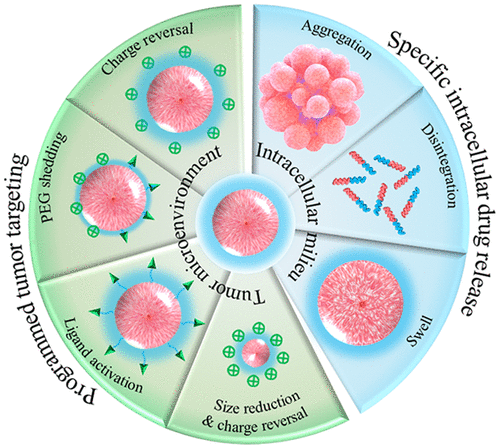当前位置:
X-MOL 学术
›
ACS Macro Lett.
›
论文详情
Our official English website, www.x-mol.net, welcomes your feedback! (Note: you will need to create a separate account there.)
100th Anniversary of Macromolecular Science Viewpoint: Biological Stimuli-Sensitive Polymer Prodrugs and Nanoparticles for Tumor-Specific Drug Delivery
ACS Macro Letters ( IF 5.8 ) Pub Date : 2020-08-24 , DOI: 10.1021/acsmacrolett.0c00488 Huanli Sun 1 , Zhiyuan Zhong 1
ACS Macro Letters ( IF 5.8 ) Pub Date : 2020-08-24 , DOI: 10.1021/acsmacrolett.0c00488 Huanli Sun 1 , Zhiyuan Zhong 1
Affiliation

|
The development of smart polymer vehicles to carry and release cytotoxic drugs to tumor tissues and cells while reducing the exposure of drugs in the blood and healthy organs is a highly challenging task with continuously growing interest from multiple fields, including polymer science, pharmaceutical science, nanotechnology, and clinical oncology. Inspired by the unique tumor microenvironment, such as mild acidity and overexpressed enzymes, functional polymer prodrugs and nanoparticles with reversible charge, detachable PEG shell, activatable ligand, and switchable size have been designed to enhance tumor deposition, tumor penetration, tumor cell uptake, and tumoral drug release. Utilizing biological signals inside tumor cells, such as acidic endo/lysosomal pH, elevated glutathione levels, and reactive oxygen species, responsive polymer prodrugs and nanoparticles with good extracellular stability but fast intracellular disintegration have been engineered for specific intracellular drug release. These biological stimuli-sensitive polymer prodrugs and nanoparticles have shown superior specificity and therapeutic efficacy to nonsensitive counterparts and, in certain cases, even clinically approved systems in varying tumor models. In this Viewpoint, design strategies and recent advances of biological stimuli-responsive polymer prodrugs and nanoparticles for tumor-specific drug delivery will be highlighted, and their challenges and future perspectives will be discussed.
中文翻译:

100周年大分子科学观点:用于肿瘤特异性药物递送的生物刺激敏感聚合物前药和纳米颗粒
开发智能聚合物载体以向肿瘤组织和细胞携带和释放细胞毒性药物,同时减少药物在血液和健康器官中的暴露是一项极具挑战性的任务,包括聚合物科学、制药科学、纳米技术在内的多个领域的兴趣不断增长和临床肿瘤学。受独特的肿瘤微环境(如温和的酸性和过表达的酶)的启发,功能性聚合物前药和具有可逆电荷、可拆卸 PEG 壳、可激活配体和可切换尺寸的纳米颗粒被设计用于增强肿瘤沉积、肿瘤穿透、肿瘤细胞摄取和肿瘤药物释放。利用肿瘤细胞内的生物信号,例如酸性内/溶酶体 pH、升高的谷胱甘肽水平和活性氧,具有良好细胞外稳定性但细胞内快速崩解的反应性聚合物前药和纳米颗粒已被设计用于特定的细胞内药物释放。这些对生物刺激敏感的聚合物前药和纳米颗粒对不敏感的对应物显示出优越的特异性和治疗效果,在某些情况下,甚至在不同肿瘤模型中得到临床批准的系统。在这个观点中,将重点介绍用于肿瘤特异性药物递送的生物刺激响应性聚合物前药和纳米颗粒的设计策略和最新进展,并讨论它们的挑战和未来前景。这些对生物刺激敏感的聚合物前药和纳米颗粒对不敏感的对应物显示出优越的特异性和治疗效果,在某些情况下,甚至在不同肿瘤模型中得到临床批准的系统。在这个观点中,将重点介绍用于肿瘤特异性药物递送的生物刺激响应性聚合物前药和纳米颗粒的设计策略和最新进展,并讨论它们的挑战和未来前景。这些对生物刺激敏感的聚合物前药和纳米颗粒对不敏感的对应物显示出优越的特异性和治疗效果,在某些情况下,甚至在不同肿瘤模型中得到临床批准的系统。在这个观点中,将重点介绍用于肿瘤特异性药物递送的生物刺激响应性聚合物前药和纳米颗粒的设计策略和最新进展,并讨论它们的挑战和未来前景。
更新日期:2020-09-15
中文翻译:

100周年大分子科学观点:用于肿瘤特异性药物递送的生物刺激敏感聚合物前药和纳米颗粒
开发智能聚合物载体以向肿瘤组织和细胞携带和释放细胞毒性药物,同时减少药物在血液和健康器官中的暴露是一项极具挑战性的任务,包括聚合物科学、制药科学、纳米技术在内的多个领域的兴趣不断增长和临床肿瘤学。受独特的肿瘤微环境(如温和的酸性和过表达的酶)的启发,功能性聚合物前药和具有可逆电荷、可拆卸 PEG 壳、可激活配体和可切换尺寸的纳米颗粒被设计用于增强肿瘤沉积、肿瘤穿透、肿瘤细胞摄取和肿瘤药物释放。利用肿瘤细胞内的生物信号,例如酸性内/溶酶体 pH、升高的谷胱甘肽水平和活性氧,具有良好细胞外稳定性但细胞内快速崩解的反应性聚合物前药和纳米颗粒已被设计用于特定的细胞内药物释放。这些对生物刺激敏感的聚合物前药和纳米颗粒对不敏感的对应物显示出优越的特异性和治疗效果,在某些情况下,甚至在不同肿瘤模型中得到临床批准的系统。在这个观点中,将重点介绍用于肿瘤特异性药物递送的生物刺激响应性聚合物前药和纳米颗粒的设计策略和最新进展,并讨论它们的挑战和未来前景。这些对生物刺激敏感的聚合物前药和纳米颗粒对不敏感的对应物显示出优越的特异性和治疗效果,在某些情况下,甚至在不同肿瘤模型中得到临床批准的系统。在这个观点中,将重点介绍用于肿瘤特异性药物递送的生物刺激响应性聚合物前药和纳米颗粒的设计策略和最新进展,并讨论它们的挑战和未来前景。这些对生物刺激敏感的聚合物前药和纳米颗粒对不敏感的对应物显示出优越的特异性和治疗效果,在某些情况下,甚至在不同肿瘤模型中得到临床批准的系统。在这个观点中,将重点介绍用于肿瘤特异性药物递送的生物刺激响应性聚合物前药和纳米颗粒的设计策略和最新进展,并讨论它们的挑战和未来前景。



























 京公网安备 11010802027423号
京公网安备 11010802027423号